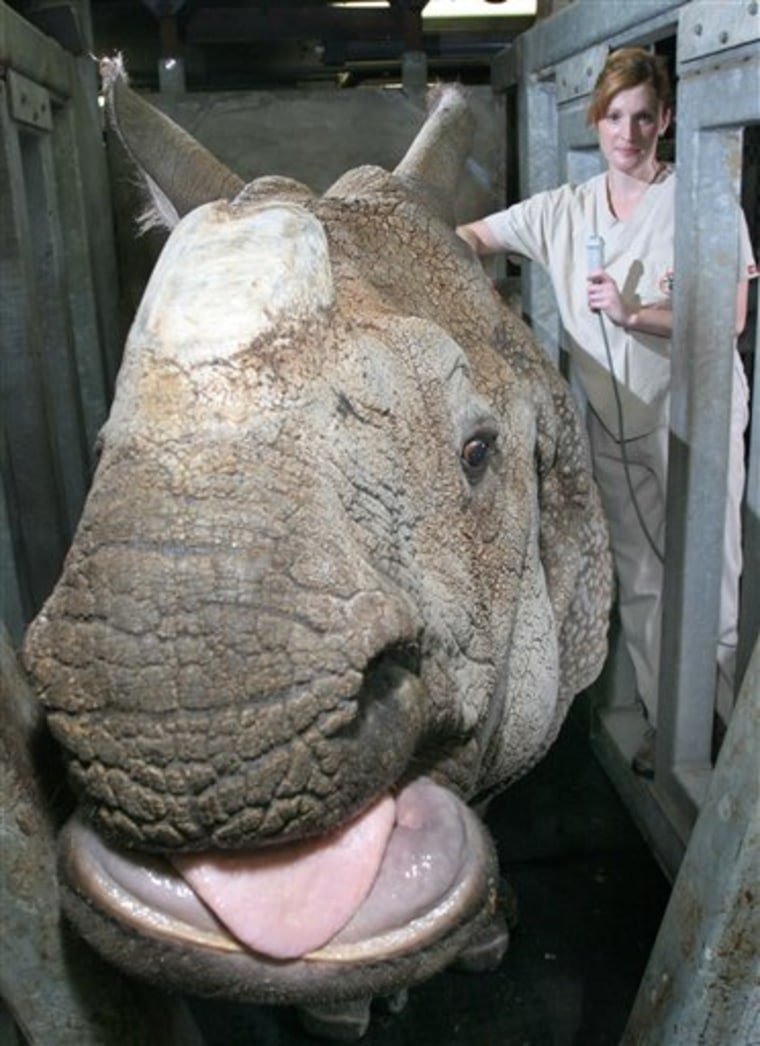The world's first Indian rhino baby to be conceived by artificial insemination is due during Christmas week at the Cincinnati Zoo.
"I think it's a remarkable achievement, an incredibly important success," said Dr. Evan Blumer, a board member of the International Rhino Foundation. "The next step is where it becomes really important. The first is to be successful, the second is to be reliable and repeatable."
Nikki, the mother, is 15 and has a life expectancy well into her 40s, so if all goes well, she could produce several more offspring.
Blumer is executive director of the Wilds, a private, nonprofit conservation reserve created on nearly 10,000 acres of reclaimed coal fields in southeast Ohio. He helped form a partnership with the Cincinnati Zoo, long known for its breeding program, where the first Sumatran rhino bred in captivity in more than a century gave birth in 2001.
Rhinos can be hard to breed naturally, Blumer said, because they can be aggressive and fight rather than mate. In fact, Nikki failed to get pregnant while at the Wilds but seemed like a good candidate for artificial insemination.
Semen was collected from Himal, a male Indian rhino at the Wilds, in November 2004 and was frozen. In August 2006, in their fourth attempt, the Cincinnati Zoo team succeeded in inseminating Nikki.
The gestation period for an Indian rhino is 16 months, so officials have waited anxiously to make the announcement Monday. Urine samples are collected several times a week to check hormone levels, and an ultrasound exam is conducted monthly.
"At this point, she's doing great," said Monica Stoops, who heads the rhino program at the zoo's Lindner Center for Conservation and Research of Endangered Wildlife.
Zoo workers, who had to design and make the equipment to harvest sperm and then deposit it in Nikki's uterus, aren't saying whether ultrasound has shown the baby is male or female.
The Indian rhino is the second-largest of five living species, about three times the size of a Sumatran at up to 6,000 pounds, standing six feet tall and 12 feet long.
Stoops had to fashion a tube two meters long to reach Nikki's uterus, to deposit Himal's sperm that was recovered — as in the domestic cattle industry, by electro-ejaculation — using a two-foot-long, low-voltage device to shock the donor's genitals.
"This whole project required innovation, because you can't just go out and buy a (rhino) probe and have it work," Stoops. "We had to develop a probe that was specifically designed for the rhino. It's got a special arc to it. It has taken a good bit of time to get that method down."
In the 20th century, the Indian rhino — native to northern India and southern Nepal — was nearly wiped out. About 200 remained before tough preservation laws began to be stringently enforced, experts say.
Although their numbers have rebounded to about 2,500 in the wild, rhino poaching remains a serious problem. The single horn, which can reach 24 inches long, is sold on the black market for use in traditional Chinese medicines and as dagger handles.
The going rate is about $17,500 a pound, Stoops said.
"It's believed (by smugglers) to have aphrodisiac powers which, of course, it doesn't," Stoops said.
It's composed of the same material as a human fingernail, she said.
Although they're a popular zoo attraction, rhinos often are misunderstood, Stoops said.
"Rhinos are the coolest animals out there. Most people miss that point," she said. "They're kind of seen as cantankerous and grumpy animals, but they're really not. They're animals that you can work with and make a big difference with."
